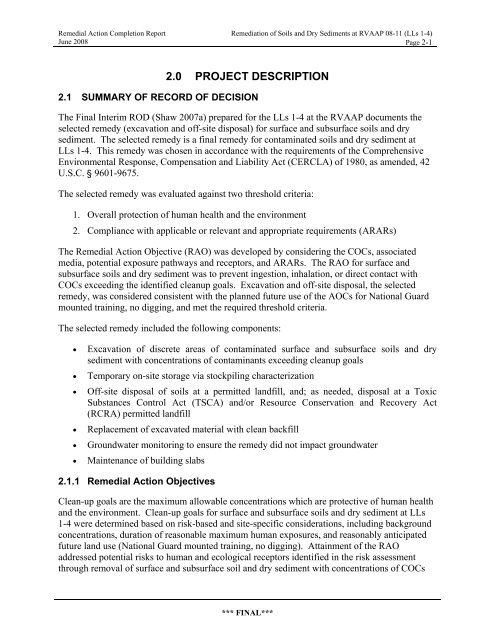Final Remedial Action Completion Report for the ... - Rvaap.org
Final Remedial Action Completion Report for the ... - Rvaap.org
Final Remedial Action Completion Report for the ... - Rvaap.org
Create successful ePaper yourself
Turn your PDF publications into a flip-book with our unique Google optimized e-Paper software.
<strong>Remedial</strong> <strong>Action</strong> <strong>Completion</strong> <strong>Report</strong><br />
June 2008<br />
Remediation of Soils and Dry Sediments at RVAAP 08-11 (LLs 1-4)<br />
Page 2-1<br />
2.0 PROJECT DESCRIPTION<br />
2.1 SUMMARY OF RECORD OF DECISION<br />
The <strong>Final</strong> Interim ROD (Shaw 2007a) prepared <strong>for</strong> <strong>the</strong> LLs 1-4 at <strong>the</strong> RVAAP documents <strong>the</strong><br />
selected remedy (excavation and off-site disposal) <strong>for</strong> surface and subsurface soils and dry<br />
sediment. The selected remedy is a final remedy <strong>for</strong> contaminated soils and dry sediment at<br />
LLs 1-4. This remedy was chosen in accordance with <strong>the</strong> requirements of <strong>the</strong> Comprehensive<br />
Environmental Response, Compensation and Liability Act (CERCLA) of 1980, as amended, 42<br />
U.S.C. § 9601-9675.<br />
The selected remedy was evaluated against two threshold criteria:<br />
1. Overall protection of human health and <strong>the</strong> environment<br />
2. Compliance with applicable or relevant and appropriate requirements (ARARs)<br />
The <strong>Remedial</strong> <strong>Action</strong> Objective (RAO) was developed by considering <strong>the</strong> COCs, associated<br />
media, potential exposure pathways and receptors, and ARARs. The RAO <strong>for</strong> surface and<br />
subsurface soils and dry sediment was to prevent ingestion, inhalation, or direct contact with<br />
COCs exceeding <strong>the</strong> identified cleanup goals. Excavation and off-site disposal, <strong>the</strong> selected<br />
remedy, was considered consistent with <strong>the</strong> planned future use of <strong>the</strong> AOCs <strong>for</strong> National Guard<br />
mounted training, no digging, and met <strong>the</strong> required threshold criteria.<br />
The selected remedy included <strong>the</strong> following components:<br />
• Excavation of discrete areas of contaminated surface and subsurface soils and dry<br />
sediment with concentrations of contaminants exceeding cleanup goals<br />
• Temporary on-site storage via stockpiling characterization<br />
• Off-site disposal of soils at a permitted landfill, and; as needed, disposal at a Toxic<br />
Substances Control Act (TSCA) and/or Resource Conservation and Recovery Act<br />
(RCRA) permitted landfill<br />
• Replacement of excavated material with clean backfill<br />
• Groundwater monitoring to ensure <strong>the</strong> remedy did not impact groundwater<br />
• Maintenance of building slabs<br />
2.1.1 <strong>Remedial</strong> <strong>Action</strong> Objectives<br />
Clean-up goals are <strong>the</strong> maximum allowable concentrations which are protective of human health<br />
and <strong>the</strong> environment. Clean-up goals <strong>for</strong> surface and subsurface soils and dry sediment at LLs<br />
1-4 were determined based on risk-based and site-specific considerations, including background<br />
concentrations, duration of reasonable maximum human exposures, and reasonably anticipated<br />
future land use (National Guard mounted training, no digging). Attainment of <strong>the</strong> RAO<br />
addressed potential risks to human and ecological receptors identified in <strong>the</strong> risk assessment<br />
through removal of surface and subsurface soil and dry sediment with concentrations of COCs<br />
*** FINAL***











